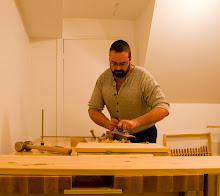I dug a little example pin-board out of my scrap pile and found another piece of wood to cut tails in. The board in question was, sadly, not quite the same thickness as the pin board, and that came back to bite me just a wee bit, but more on that later.

So I marked out each end of this little bit of wood from the same pin board. One set on each end. I then marked them 'saw' and 'pare' and started sawing. The 'pare' end was sawed with about 1/16" left to pare away to get to the line. The 'saw' end was sawed right to the line. Here is the 'pare' end:

The 'saw' end went together as per normal. Unfortunately, since the pin board had come out of the scrap bin and it was slightly thinner material than the tail board, the pins are a bit short, but that's of no real importance here. What matters is the fit between the pins and tails. Here is the 'saw' end of the board:
 It turned out well enough, tight enough that the glue-up would sort out its minor problems. It went together with firm hand pressure, and squeaked as it did so (you've got to like the squeak!).
It turned out well enough, tight enough that the glue-up would sort out its minor problems. It went together with firm hand pressure, and squeaked as it did so (you've got to like the squeak!).The pared end was a shambles. Why? Despite my spending at least three times longer on it than the saw-to-line end, and using honest-to-gosh paring chisels sharp enough to do cataract surgery with, it was miserable to try to pare a flat plane in the right location. Why is that? That's because there's only a scribe mark on one side of the piece! How are you supposed to get the plane in the right place with only a depth and one side? it was misery. No doubt if you were a person who used various jigs and appliances to cut dovetails such that you didn't have to worry about maintaining the vertical plane, etc. you'd be alright, but I found the experience far from rosy.
Oh, here's a shot of the pared-end of the board, showing the gappy dovetails:

Bottom line? The saw, properly used, always gives you a nice, flat plane and is far more predictable than trying to pare free-hand after the fact. I'm going to stick with sawing to the line, particularly since it's hugely faster!

1 comment:
Yep, cut to the line every time. I find it actually easier to repair a miscut when it happens that to cut fat and pare every time. I'm in agreement with you. Every time I've tried to cut fat and pare, it has made matters worse.
Post a Comment